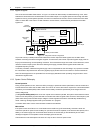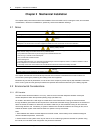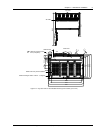
Chapter 1 General Description 3
HIPULSE U UPS Single Module And “1+N” (Expandable) 160/200/300/400kVA User Manual
Return of power mains
When the mains returns within the required tolerance, the rectifier will start up again automatically and gradually
(power walk-in), supplying power to the inverter and recharging the battery at the same time. There will be no
interruption of the critical load.
Off-battery
If the battery system only is taken out of service for maintenance, it is disconnected from the rectifier/charger and
inverters by means of (an) external disconnect breaker(s). The UPS shall continue to function and meet all of the
specified steady-state performance criteria, except for the power outage back-up time capability.
UPS module fault
In the event of an inverter fault, the static transfer switch will automatically transfer the load onto the bypass mains
with no interruption. In such an event, seek technical assistance from Emerson local customer service center.
(“1+N” parallel UPS system) In the event of a fault in a unit, the unit’s static transfer switch will automatically
exclude the unit from the system. If the system is still capable of providing the required load, the remaining units will
continue to supply the load with no interruption. When the units still present in the system are no longer capable of
fulfilling power requirements, the load will automatically be transferred onto the bypass mains.
Overload
In the event of an overload at the inverter output which lasts longer than the typical time/current (refer to table 8-6),
the inverter will shut down and the static transfer switch will automatically transfer the load onto the bypass mains
with no interruption. If the overload falls within the typical time/current that has been specified, the load will be
returned to the inverters when the power drops to a level which can be supported by the number of active units in the
system (parallel “1+N”).
In the event of a short circuit in the output, the load will normally be transferred onto the bypass mains, which will
cause the inverter to shut down. This switch is determined above all by the features of the protective devices in use in
the system.
In either case, an alarm message will appear on the operator control and display panel of the UPS.
(“1+N” parallel UPS system) The control logic system constantly monitors load requirements and controls the power
supplied by the UPS modules. In the event that an overload condition is sustained for greater than a preset time, the
load will transfer to the bypass mains supply, when the number of active modules is unable to satisfy load
requirements. The load returns to the inverter supply if the power is reduced to a value that can be sustained by the
number of active modules in the system.
Maintenance bypass
A second bypass circuit contained in the UPS cabinet, identified as the maintenance bypass line, is included to
enable a raw mains supply to be made available to the load while facilitating a safe working environment for carrying
out scheduled UPS system maintenance or trouble shooting. The circuit is manually selected by the maintenance
bypass switch in the OFF position.
Warning
The internal maintenance bypass must not be used when the UPS system is comprised of more than two UPS modules in
parallel.
CAUTION: If an automatic circuit breaking device is not present in the input distribution panel, there remains a dangerously high
voltage at the output busbars and also on the input busbars of the UPS module that is switched off.
1.2.4 ECO Mode (For Single UPS Only)
In ECO mode, the system prefers to put the load on the bypass mains, with the inverter on stand-by. The load is
switched over to the inverter when the mains goes outside of standard frequency and voltage values (settable).
The ECO mode configuration requires a different setup in the default menu configuration.


















